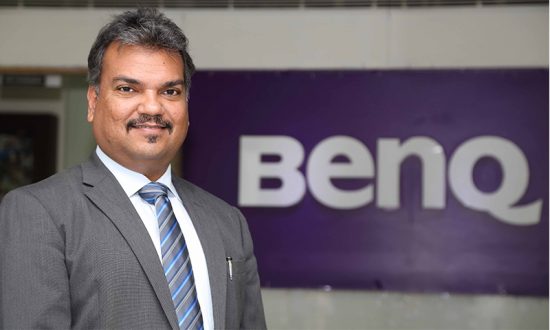BenQ India, part of the 25-billion-dollar BenQ Group, has been in India since 2001. Its product portfolio, catering to both B2B and B2C customers, has steadily contributed to the growth of BenQ Group, through an innovative product strategy and solutions. Rajeev Singh is Managing Director of BenQ India, and he has led the journey of this brand in India and comes with wealth of knowledge in the sector. In a conversation with Higher Education Digest, Rajeev Singh talks about BenQ’s current offerings and solutions for the Indian market, BenQ’s efforts in helping the local government schools, and much more.
How will Smart Projectors/smart displays transform post-COIVD education format?
Post-COVID is never going to be same as before, the pandemic-led crisis has caused business disruptions and a ripple effect can be seen by every industry but it has also given rise to huge opportunities to business to rewrite the business model. Today the education sector is witnessing a major shift to blended learning. Virtual classrooms are going to stay and hang around for some time. Therefore it becomes of prime importance to ensure the equipment used to conduct these classes online for the teacher, and the right equipment for the student to understand concepts just like they would in a classroom. Not only corporates but educational institutes are also adopting the display learning method and to concentrate the impact it is very vital to provide the right display for the more personalised learning experience.
What are BenQ’s current offerings and solutions for the Indian market?
BenQ India is part of the larger BenQ Group, a world-leading human technology and solutions provider continuously focussing on enriching the aspects of life that matter most today like – lifestyle, business, healthcare and education. As a company that focuses on immersing the viewer with the world of Visuality, BenQ’s display solutions help viewers embrace and understand the power of visual communication – as intended by the makers of the image or the video. In India, the current product portfolio of BenQ caters to both B2B and B2C consumers and comprises of technology like Projectors, LCD Monitors, Large Format Display which include Smart Signage and Interactive Flat Panels.
BenQ is the undisputed market leader with the No. 1 position in the Indian projector market with a market share of whopping 28.6%. Not just that, BenQ is also the no. 1 brand in the 27” LCD Monitor segment and currently the fastest growing monitor brand in the country.
Tell us about the importance of market expansion for BenQ, its strategy and the way forward.
BenQ has had to revisit its market expansion strategy in the wake of the pandemic. There has been a major shift in the ratio of sales from B2B to B2C. The consumer segment has seen a major rise with the focus on Study at Home. With the increased amount of time being spent at home, the displays have a very important role to play. It is now imperative more than ever to choose displays which also take care of one’s health. BenQ has realized and to meet the demand for the same has expanded their portfolio of eye care monitors which also come with height adjustment feature.
Study from home requirements has had a major impact on increasing demand of LCD Monitors. E-Commerce platforms have contributed majorly to this growth in LCD Monitor business for BenQ which has grown by over 200% during this time.
The education segment has had to suffer in the previous year. But in 2021 we can foresee the adoption of technology by the educational institutes will be higher as they have to focus on Blended learning, in order to cater to the new model of imparting education.
Why is visual learning considered as the next big thing in education sector?
While we all have taken our learnings from COVID-19, for the education sector, bedrooms converted into classrooms, screens into blackboards, keypads into pens and subjects into modules.
COVID-19 has added a new buzz word i.e. edtech, which has added a new layer to the existing traditional system. This new layer can be a game-changing experience to the way students access education, the way students harness the opportunity
The future of the education sector will be blended learning. A viable model for the future of education is that it is powered by visuality. Adopting a visuality powered blended learning strategy provides a complete package to fulfilling the needs of educating future generations. Hi-tech digital tools like smart projectors, interactive smart screens, web-cameras and monitors will enable easy in learning. With easy wireless sharing of teaching material across devices, teachers are able to seamlessly connect while paying individual attention to the students.
How will technology bridge the gap between government and private school education models?
Learning is always about accessing to the right set of information and technology has bridged that gap. Today everyone who has internet connectivity can access the same information. This is bridging the gap of accessing the information. Including technology in rural education, for sure, is harder than it is for a tech-abundant society but with the right resources and support of the local stakeholders, students from the hinterlands of India can equally benefit from technology. Today Indian government are investing heavily in edtech sector to provide them with the equal opportunity of learning in govt. schools as well.
How is BenQ helping the local government schools to provide education in semi-urban areas?
BenQ’s display products have been at the fore front when it comes to transforming a traditional classroom to digital classrooms. And when it comes to Blended Learning BenQ has a huge array of products right from Short Throw and Ultra Short throw projectors to Smart Projectors to Interactive Flat panels.
BenQ has transformed more than 3 lac classrooms in India till date. BenQ products have been at the fore front of digitizing the classrooms in the government schools of various states. One of the largest deployment was done by in the government schools of Kerela. Partnered with the Government of Kerala for implementation of digital classrooms wherein we supplied 47,000 projectors during the year 2018-19. Similarly, we partnered with the government of Daman and Diu to transform their government school classrooms by deploying around 600 units of Interactive Flat Panels. These are some of the largest association with the Government schools.
How can technologies bring a more sustainable India?
Sustainability can be a complex and somewhat never-ending topic, developing a sustainable ecosystem is not the job of one industry, it’s a collaborative effort of all together. Technology no doubt will play a dominant role with the support of the right policy framework. The battle to ensure our cities are sustainable has just begun. There is a long way to go to solve the problems we face. Much work needs to happen on both the infrastructure side and in changing well-entrenched personal habits.




